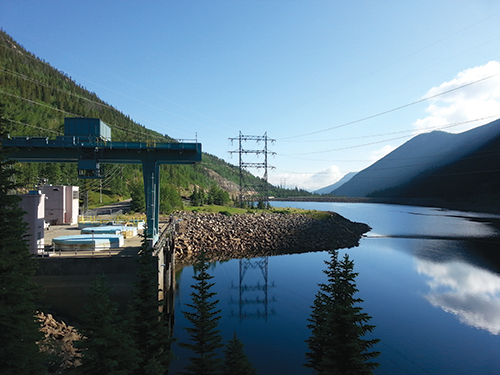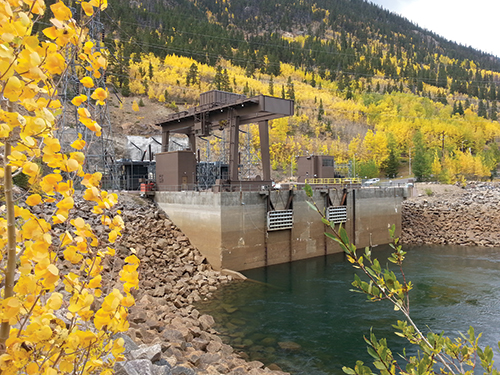Aging infrastructure is a well-recognized challenge across our nation’s energy system with investor-owned utilities spending a record of $19.5 billion in electric transmission infrastructure last year. Top of mind when considering this challenge are typically T&D lines, older coal generation plants, or outdated substations. Renewables are rarely part of the discussion unless the focus is on integrating newer wind and solar technologies with an aging grid. However, hydroelectric power is one of the oldest methods of producing energy with no air, water, or land emissions, and the age of the country’s hydro resources should not be overlooked especially as more utility customers are demanding increased renewable sources.
In the early 1900s hydroelectric power accounted for more than 40 percent of the country’s electricity supply. That number has fallen significantly in the last century, but the legacy of hydro power remains. To maintain this legacy of hydro power, utilities are focusing on upgrading hydro plants that generate this reliable, renewable energy source to provide more options for peak generation and customer choice.
Cabin Creek: A 1967 Engineering Marvel
Xcel Energy’s largest pumped storage hydro facility, Cabin Creek, is nearly 50 years old. Cabin Creek came online in April 1967 and has provided peak power supply nearly every day since. When built, Cabin Creek was an engineering marvel. It was the highest altitude pumped storage plant in the world, containing the second largest reversible pump/ turbines operating in the United States. The pump/turbines could generate and pump at a record-high hydraulic head and unit operating speed.
From the end World War II until the mid-1960s, Colorado’s system load had increased by more than six-fold. Capacity additions, for the most part, had involved base load units throughout this period. Recognizing that peaking capacity would markedly improve the load factor on efficient base load units, the company embarked on the installation of Cabin Creek.
The plant, located about 35 miles west of Denver, is situated south of Georgetown, Colo., with the powerhouse and lower reservoir at 10,000 feet elevation and the upper reservoir at 11,200 feet. The steep elevation change between the upper and lower reservoirs formed a significant difference in height between the water source and outflow creating what is known as a high head and making it ideal for a pumped storage project. Plus, it was close to a major load concentration of the Denver metro area and an established transmission line. The steep sides of the valley also permitted the reservoirs to be connected by a tunnel of only 4,300 feet in length, relatively short for the high head and large capacity.

The unique location also had its challenges, though. The icing conditions created by severe winter temperatures at the 10,000 and 11,000-foot altitudes required special attention in design of the facility. The engineering team allowed for 2.5 feet of ice on the surface of both reservoirs and a minimum of 20 feet of water was provided over the tunnel inlet/outlet structure.
In addition, the electrical design of the substation required the analysis of special problems related to the selection of proper materials and equipment to meet the unusual environmental conditions. The 13.8/230-kv step-up transformers had high altitude bushing rated at 825-KV BIL, substantially higher than would be required at lower altitudes. Protection of the transformers required the use of station-type high altitude lightning arrestors. Transient analyzer studies were conducted to determine proper ratings for switching surges.

At the time of commissioning, the plant was extremely innovative and even won the Edison Electric Institute’s highest honor, the Edison Award, in 1968. However, in the nearly 50 years since, not much has changed at the plant so the necessity for upgrades is reaching a critical point.
Plant Operations Then and Now
Cabin Creek today consists of two generators with a capacity of 162 MW each, totaling 324 MW. Cabin Creek generates electricity by releasing water from an upper reservoir through a tunnel, which turns the turbine generators. The water is then stored in a lower reservoir. The upper reservoir has 1,192 feet of head that equals a pressure of approximately 550 psi. At full load, this equates to about four hours of running time. The lower reservoir has 1,977 acre-feet of usable water and is considered empty at 9,974, at which point there is still 45 feet of water. The upper reservoir may change during normal daily operation from 11,194 feet to 11,140 feet, and the lower reservoir may change from 9,979 feet to 10,007 feet.
During off peak hours at night when customers’ electricity use is low, water is pumped back to the upper reservoir and stored when there is less energy demand or when wind generation is available. In that manner, it operates much like a giant battery that Xcel Energy can tap when it is needed most. With more variable energy resources like wind being added to the system, Cabin Creek’s energy storage benefits to reduce wind curtailments and the cycling of coal and natural gas resources are valuable in balancing the system requirements. The units can quickly be dispatched to pump mode, which adds load to offset excess generation and helps the maintain energy balance.
Cabin Creek is routinely used to meet a significant portion of Xcel Energy’s operating reserve requirements in Colorado. In addition to providing power to balance the energy mix/daily peaking, Cabin Creek is often used as an emergency reserve facility. It can balance the energy system when there are fluctuations in wind energy availability or serve as a reserve when customers’ energy demand is high. While in pump mode, Cabin Creek provides non-spinning reserve (responsive load that is off-line but can be fully responsive within 30 minutes or less).
Each generator can go from complete stop to fully loaded in 10 minutes or less, making it essential for peak demand times and emergency situations. Cabin Creek is also unique in its ability to ‘black start.’
Cabin Creek can start up with only the use of station batteries in an emergency situation. The team tests black start procedures once a year and participates in annual drills with local emergency responders. It can also start the Georgetown hydroelectric plant without external power and feed Cabin Creek. The station batteries last about 4 hours.
In addition to controlling its own operations, using the same switchboard that was used in 1967; Cabin Creek operates all remaining five Xcel Energy’s Colorado hydro plants. Its control room is manned 24-hours a day, 365 days a year.
Its role in peak generation, emergency backup, and operation controls make it critical to the future of Xcel Energy’s energy balance and reliable generation requirements. Plus, as customers push for more and more renewable energy sources and options, Cabin Creek will remain a vital asset to balance variable wind resource and provide additional renewable generation.
The Necessity for Upgrades
Now that the facility is nearly 50 years old, it is reaching the end of its useful life. The age and condition of the equipment are such that it needs major refurbishments to continue operating reliably.
In May 2015, Xcel Energy filed a plan with the Colorado Public Utilities Commission (PUC) to upgrade Cabin Creek to increase the capacity and extend the life of the pumped storage hydro facility. The utility requested approval to spend approximately $88 million on a 5-year refurbishment project.
The project includes upgrading the two pump-turbine units by 36 MW, or the equivalent of the electricity needed to power approximately 27,000 homes, to a total of 360 MW. It also includes increasing the size of the upper reservoir by installing a parapet wall – an upward extension of the dam – that would provide an additional 75 acre-feet of water storage capacity.
The upgrade project will replace the runners (water wheels) with upgraded designs, improve the hydraulic flow through the inlet gates, raise the level of water that can safely be contained in the upper reservoir, refurbish or replace the remaining generation components to a like-for-like state, and improve the roundtrip efficiency. The refurbished facility will be designed to pump and generate more efficiently, finding the ideal balance between pumping the upper reservoir more quickly for a faster turnaround and maximum generation. Given the unique location and high altitude, Xcel Energy will work closely with contractors familiar with the environment and with extensive experience working on both the electrical and mechanical side of hydroelectric operations in order to meet its rigorous safety, budget, and timing goals.
The project is anticipated to take 60 months to complete, planning to come online in early 2020. Given the emergency and peak demand functions of the plant, the team will take one unit out of service at a time over a 9 month period to enable ongoing operations during construction. With one unit, the plant will still be able to black start if necessary and can generate 75 MW base load running for approximately 14 hours.
In addition, the upgrades will include modernizing the control system. It currently uses some of the same switches installed in 1967 to control Cabin Creek. With the upgrades, it will move to data-controlled systems, which will increase efficiency and decrease the potential for operator error. Similar to the generator unit replacement process, the controls will be upgraded one at a time to minimize any disruptions.
These upgrades will extend the life of Cabin Creek by making smart investments to modernize the plant, leading to efficiency improvements, expanded storage capacity, and increased size of the upper reservoir. The Federal Energy Regulatory Commission (FERC) issued a license renewal for continued facility operations, predicated on the construction upgrades, which will allow Xcel Energy to operate the hydro facility for at least another 40 years.
Understanding the importance of this project, the Colorado PUC approved Xcel Energy’s request soon after filing. It stated the refurbishment was “essential to support reliable, economic service beneficial to customers.” Moving forward, Cabin Creek will be able to reliably operate and provide renewable generated energy for decades to come. The approved upgrades expand the utility’s portfolio of renewable energy sources and ability to develop new programs to give customers more choices in the energy they use.
About the Author
Bruce Cotie is a plant manager with Xcel Energy, where he oversees nine generation plants across the Public Service of Colorado operating company’s service territory. After a career in the Navy assigned to the machinery division on a nuclear powered submarine, he has 12 years of operating and maintenance experience with Xcel Energy in the areas of coal-fired generation, combustion turbines and wind farm facilities.







